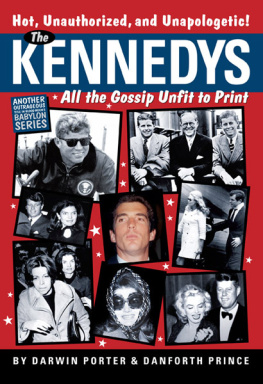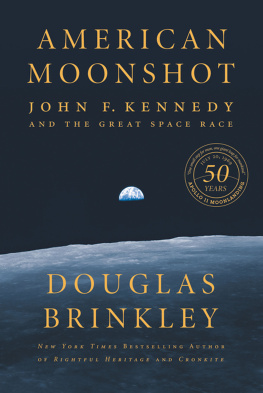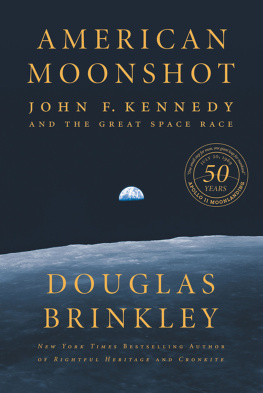THE SPACE-AGE PRESIDENCY OF JOHN F. KENNEDY
THE SPACE-AGE PRESIDENCY OF JOHN F. KENNEDY

A Rare Photographic History
JOHN BISNEY AND J. L. PICKERING
Foreword by Christopher C. Kraft Jr.

2019 BY THE UNIVERSITY OF NEW MEXICO PRESS
All rights reserved. Published 2019
Printed in Korea
ISBN 978-0-8263-5809-7 (CLOTH)
ISBN 978-0-8263-5810-3 (E-BOOK)
Library of Congress Cataloging-in-Publication data is on file with the Library of Congress
Cover illustration courtesy of the John F. Kennedy
Presidential Library and Museum
DESIGNED BY TERESA W. WINGFIELD
CONTENTS
Christopher C. Kraft Jr.
John Bisney
FOREWORD
AT THE TIME OF ALAN SHEPARDS first US manned space flight in May 1961, there was great interest in the country regarding the launch and the subsequent results. The worldwide response, however, was overwhelming and unexpected. It was this reaction that prompted the Kennedy White House to ask NASAs leadership to brief the president on its present status and what the agency might be considering beyond the coming first orbital flight of Project Mercury. In this meeting, the president stated that he had been very impressed with the tremendous response throughout the world. It was obvious that he was considering how this might be used as an exhibition of the preeminence of the United States.
The NASA leaders were somewhat taken aback by the presidents query but told him that they had been giving some thought to a manned flight around the moon and that with a large increase in their budget, it might be possible to perform such a difficult mission in maybe ten years. It was obvious that the president liked this idea, and he asked immediately, Why just fly around the moon? Why not land? That question spawned the eventual goal for Project Apollo. It took a while to arrive at that point, but the president made two speeches committing the nation to a lunar landing programone before Congress and one at Rice University in Houston. These two speeches are part of one of the greatest decisions made in US history.
Another great aspect about President Kennedy was the inspiration he provided to Apollo, not only to those directly involved in the program but to the American people in generalsurely this made him one of the greatest leaders of all time. (I was honored to receive the John F. Kennedy Astronautics Award for 1996.)
This book is a chronicle of the presidents visits throughout the United States to several locations where the work toward Apollo was taking place. Many directly involved with NASA and the aerospace industry are seen briefing the president on their activities. This was no small task because of the thousands of people involved. There was hardly a state in the country where Apollo was not represented (an indication of the large economic and scientific impact of the program). At the peak of the Apollo program, approximately four hundred thousand people were involved. It was my privilege to serve as the flight director during all six of the manned Mercury missions, and subsequently first as the director of Flight Operations at the Manned Spacecraft Center and later as the center director.
From a personal point of view, I considered President Kennedy one of the finest leaders I have known. At the time I thought he was divinely inspired, and his assassination was a terrible blow to all of us. For that reason I give President Lyndon Johnson high praise for continuing the Apollo program.
DR. CHRISTOPHER C. KRAFT JR.
Houston, Texas
ACKNOWLEDGMENTS
WE WOULD LIKE TO EXTEND a special thanks to Laurie Austin, Maryrose Grossman, and Heather Joines of the John F. Kennedy Presidential Library and Museum for their wonderful hospitality, cooperation, and knowledge. Our appreciation also to Jill McLaughlin and Tris DeRoma at the Los Alamos Monitor for their help with locating retired Los Alamos Labs workers, and to Mahlon T. Wilson for reviewing that chapter. Thanks as well to Alan Brady Carr for providing a wealth of photos from the Los Alamos National Laboratory Archives. Others who helped make this book possible include:
Zamir Ahmed
Darren Court
Joel Dahlby
Sid Davis
Jim Eckles
Harold Finger
Harold P. Gerrish Jr.
Ed Hengeveld
Clint Hill
Christopher C. Kraft Jr.
Alan Lawrie
H. H. Luge Luetjen
Roger McCormick
Doyle Piland
Lutisha Piland
Donald J. Prichard
James Ragusa
Morgan Raines
Bob Sieck
Reece Schonfeld
Stephen C. Smith
Kris Stoever
Jeffrey Thomas
Mark Usciak
Tom Usciak
Jonathan Ward
INTRODUCTION
JOHN F. KENNEDYS political life was unavoidably shaped by the geopolitical struggle between the United States and the Union of Soviet Socialist Republics (USSR) following World War II. When he first ran for office in 1946, however, he could never have envisioned himself as the driving force behind putting the first man on the moon. Yet fifteen years later, it became a major goal during his presidency in a dramatic space race pitting the two former war allies against each other.
At stake was perhaps world dominance, or at least influence, through advanced military weapons systems that would exploit the next great unexplored frontier: outer space. During the late 1940s and 50s, both nations had developed long-range missiles and aircraft that could reach targets around the globe carrying nuclear warheads, creating a new, uneasy standoff, dubbed the Cold War.
By the time he is the Democratic nominee for president in 1960, a perceived missile gap (a term first coined by Kennedy in 1958 and repeated during his Senate reelection campaign that year) between the two superpowers is a major national issue. In campaign speeches in September, Kennedy says, I am not satisfied as an American to be second to the Soviet Union in sending a missile to the moon or sending Sputnik around the globe and We are in a strategic space race with the Russians, and we have been losing... if a man orbits the earth this year, his name will be Ivan.
During his third debate with Republican nominee and Vice President Richard Nixon in October, Kennedy portrays the competition as critical to US leadership:
If we are on the mount, if we are rising, if our influence is spreading, if our prestige is spreading, then those who stand now on the razor edge of decision between us or between the communist system, wondering whether they should use the system of freedom to develop their countries or the system of Communism, theyll be persuaded to follow our example. There have been several indications that our prestige is not as high as it once was. Mr. George Allen, the head of our information service, said that a result of our being second in space, in the Sputnik in 1957, and I quote him, I believe I paraphrase him accurately. He said that many of these countries equate space developments with scientific productivity and scientific advancement. And therefore, he said, many of these countries now feel that the Soviet Union, which was once so backward, is now on a par with the United States.









